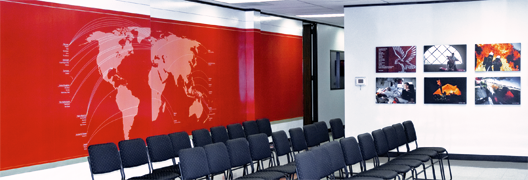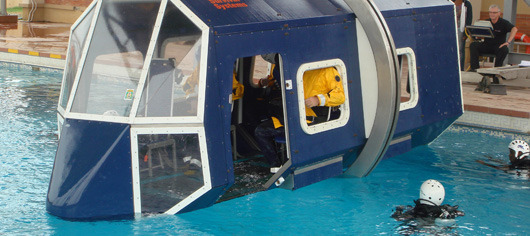HOW TO ESCAPE FROM A SUBMERGED HELICOPTER–Part 2 Life imitating art
In my prior post, I talked about my upcoming visit to an oil rig during my trip to Ghana February 2 – 14. To do that, I need to have certain certifications and authorizations. The first is a medical exam by an OGUK physician. This is a specific oil & gas industry exam that you won’t find at any ol’ clinic. The closest such physician to me is in San Diego, California, about 120 miles away. So last week I made the 2-hour trip there from Pasadena where I live. The examining physician gave me a clean bill of health, including, it seems, very good hearing acuity, which is part of the required testing.
With that taken care of, I moved on to the second step, which was to take the BOSIET, an internationally recognized 3-day course that bestows a certificate valid for four years. Although there are small differences in the course content between different training centers, a certification from say, Australia, would be recognized in the US or Ghana, etc. These centers are about as few and far between as the OGUK providers. I chose Falck Safety Services in Houston, flying in on Sunday, January 19, a day before the start of the course. Falck, a Danish company founded by Sophus Falck, has a wide global presence, and is one of the world’s biggest security and emergency services corporations. Running six training centres in Louisiana and Texas, it is the leading provider of safety training and offshore services primarily to operators in the Gulf of Mexico.

LOBBY AT THE HOUSTON FALCK CENTER (Photo: Falck.com)
In the company of oil & gas veterans
At 7:30 AM sharp Monday morning, we began the first full day of BOSIET. Including me, there were fourteen attendees–I’ll call them “trainees” for lack of a better word. All except me were connected in some way to the oil and gas industry, and it seemed that all, with perhaps one or two exceptions, had worked on oil rigs associated with multinational companies like Chevron, Exxon, Haliburton, Baker Hughes, Schlumberger. Many of the trainees were very experienced in their fields. An engineer who sat a few spaces from me and who was one of the only two women present, had been stationed in multiple regions of the globe, including tough environments like Nigeria where the accommodations were difficult and security was tight. Sitting to my left was a young guy, Nat, shortly to be posted to a petroleum exploratory vessel off New Zealand, which country is famous for being the location for the film The Hobbit. Nat appeared to have worked in every possible type of oil installation the world over and had been in several different kinds of emergency situation. To my right was a man who would be going off to Angola almost as soon as he was done with the course. The age range of the attendees I would say was early thirties to mid-fifties.
It was clear that I was the only one of my kind in the group. A physician-author in the midst of oil and gas workers was definitely something of a curiosity, although one of the instructors told me that they had once a student who was a local journalist doing research on the Falck course. I might pause here to state what is pretty obvious: I was far out of my comfort zone and doing something that I didn’t really have to. The other trainees were mandated to be there by their companies, which were paying the somewhat hefty fee for the course. The chance of my ever going into oil and gas is about as close to zero as possible. Then why should I bother? Because the oil and gas industry is at the heart of my novel, MURDER AT CAPE THREE POINTS. In writing my novels, I try to experience as much as possible of what my characters and protagonist go through (that doesn’t include being murdered, as a friend of mine pointed out). Readers vicariously live through the scenes and stories in a novel, and I think the least I can do is have the real experiences on their behalf. Darko goes through the BOSIET in MAC3P and he goes to an offshore oil rig in Ghana. So I need to do the same.
Theory and practice
The first day at Falck was spent in the classroom being instructed on fundamental principles of oil exploration, deep sea installations, safety concepts on the rig and in water, ocean survival techniques, firefighting and a little about CPR. At first I found the atmosphere in the classroom a little stiff and uncomfortable, with a sense that the trainees would much rather be somewhere else. Of course that’s common, and I’ve experienced much the same thing attending required medical certification programs like Advanced Cardiac Life Support (ACLS). But gradually there was some thawing out among the trainees, especially by the second day. Having done a little teaching myself, this stiffness can also be difficult for the instructors, although some more than others have the knack of drawing people out. On the other side, some attendees are more outgoing and verbal than others, while others say not a word from start to finish.
The Falck trainers are highly competent and professional, and a couple of them used humor effectively in their teaching, something I’ve always admired. In general, the entire course ran like clockwork without a hitch from beginning to end. Remember also that Falck simultaneously handles multiple types of safety certifications, not only BOSIET. All in all, I highly recommend Falck should you need to obtain or update your Bosiet, which I’m sure most of my readers do. I kid, of course. The only minor snag at the Houston center was with my name, which had been spelled Kwel instead of Kwei, and there was nothing I could do to reorient the instructors to say it correctly (pronounced “Quay,” rhymes with “say,”). Won’t be the first or last time that happens to me.
The submersion to end all submersions
It was on the second day in the afternoon that we had the Helicopter Underwater Escape Training (HUET). Undoubtedly the most anticipated and prominent part of the course, it is training provided to oil and gas personnel who are regularly transported to and from oil installation facilities by helicopter over water. As the name implies, the purpose is to prepare them for emergency exit in the case of a crash-landing on water, or ditching, and the training session culminates in a full capsize of the training module.

HUET MODULE FOR FOUR PASSENGERS
We were given full classroom instruction on HUET during the morning session. In the afternoon, we suited up for the actual exercise. The first layer of clothing is an ordinary coverall. Over that goes a survival suit, a lifejacket and an unique emergency breathing device called an Air Pocket Plus (APP). It’s used with a snorkel-like mouthpiece and allows you to breathe underwater using your own exhaled air (might sound odd, but it works.) Additionally everyone wears a helmet, and Crocs for the feet. In tropical climates like the Gulf of Guinea off Ghana’s coast, the survival suit is not used because it would simply be unbearably hot.
As we numbered fourteen, we were divided into three groups of four (the capacity of the module), and one of two. The lead-up to the ultimate drill, which would involve activating the lifejacket for flotation after escaping the craft, was preceded by gradual steps: being in the module at the water’s surface without submersion, followed by partial submersion, then full submersion without 180-degree capsize, and finally full submersion with capsize. Each group did each phase before proceeding to the next.
I have swum since I was a small boy, so am very comfortable in a pool environment. I must tell you, however, that this is a very different kettle of fish. I did fine up until the capsize, but on being turned upside down underwater, I quickly found myself wildly disoriented. The key is to never let go of the landmarks as the module makes its 180 rotation: your window, and your seatbelt. Open the window first, release the seatbelt second. I know that now, of course, but let’s just say that at the time I pretty much forgot those instructions and found myself flailing. I messed up royally on the first two submersion exercises and had to repeat one, but I’m happy to say that I forced mind over matter on the final maneuver, and managed to emerge okay, after which I activated my lifejacket. I wanted to go one more time, but the instructor and divers disallowed that. I think I had stressed them out quite enough.
Life imitating art
I wrote the scene in MAC3P involving Darko undergoing HUET before my own experience of it. It was remarkably, almost eerily, accurate. In fact, if you want a fuller description of what it was actually like to be underwater, you’ll find it in the fictional but, as it turns out, realistic scene in MAC3P. I’m not being coy. I think if I told all in this blog, it would act as a spoiler for those who intend to get my book. The next piece that will be subjected to reality testing is the scene with Darko on the oil rig, also written before the fact. How realistic is it, and how closely did life imitate art? We will find out on February 3rd.



